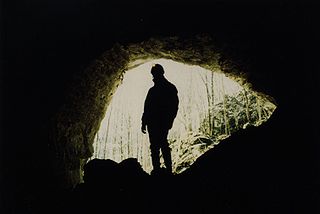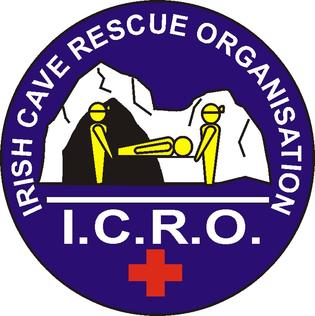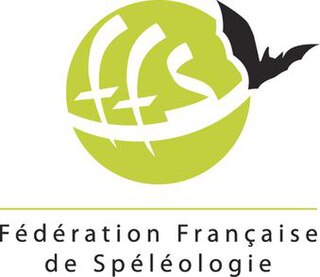
Speleology is the scientific study of caves and other karst features, as well as their make-up, structure, physical properties, history, life forms, and the processes by which they form (speleogenesis) and change over time (speleomorphology). The term speleology is also sometimes applied to the recreational activity of exploring caves, but this is more properly known as caving, potholing, or spelunking. Speleology and caving are often connected, as the physical skills required for in situ study are the same.
Sheck Exley was an American cave diver. He is widely regarded as one of the pioneers of cave diving, and he wrote two major books on the subject: Basic Cave Diving: A Blueprint for Survival and Caverns Measureless to Man. On February 6, 1974, Exley became the first chairman of the Cave Diving Section of the National Speleological Society. During his career, he established many of the basic safety procedures used in cave and overhead diving today. Exley was also a pioneer of extreme deep scuba diving.

The National Speleological Society (NSS) is an organization formed in 1941 to advance the exploration, conservation, study, and understanding of caves in the United States. Originally headquartered in Washington D.C., its current offices are in Huntsville, Alabama. The organization engages in the research and scientific study, restoration, exploration, and protection of caves. It has more than 10,000 members in more than 250 grottos.
Formed in 1956, the Australian Speleological Federation Inc. (ASF) is the national body representing those interested in the protection and sustainability of Australia's cave and karst environments. It has approximately 850 members across 28 constituent bodies throughout all Australian states and territories.
The University of Bristol Spelæological Society (UBSS) was founded in 1919 by cavers in the University of Bristol. Among its earliest activities was the archaeological excavation of Aveline's Hole.

The British Cave Research Association (BCRA) is a speleological organisation in the United Kingdom. Its object is to promote the study of caves and associated phenomena, and it attains this by supporting cave and karst research, encouraging original exploration, collecting and publishing speleological information, maintaining a library and organising educational and scientific conferences and meetings.
There are a number of caving organizations throughout the world.

Recreational caving in the United Kingdom dates back to the mid nineteenth century. The four major caving areas of the United Kingdom are North Yorkshire, South Wales, Derbyshire, and the Mendips. Minor areas include Devon, North Wales, and the Scottish Highlands.

The Irish Cave Rescue Organisation (ICRO) is a voluntary body responsible for cave and abandoned mine rescues within the island of Ireland. The organisation attends, manages and carries out rescues at the request of the Garda Síochána in the Republic of Ireland and the Police Service of Northern Ireland (PSNI) in Northern Ireland, United Kingdom, and is responsible to both police services.
Cave conservation is the protection and restoration of caves to prevent or minimise the effects of human activities.

The French Federation of Speleology, is a French organisation that represents all persons practicing or studying caving and canyoning and promotes the study and conservation of caves.
John (Jack) Cristopher Coleman (1914–1971) was a respected Irish geographer, archaeologist, speleologist and mountaineer. He devoted much of his life to the study of the caves of Ireland, the product of which were his many contributions to scientific journals in Ireland and the United Kingdom, his founding of the Speleological Society of Ireland and the publishing of his book, The Caves of Ireland.

Agnes Milowka was an Australian technical diver, underwater photographer, author, maritime archaeologist and cave explorer. She gained international recognition for penetrating deeper than previous explorers into cave systems across Australia and Florida, and as a public speaker and author on the subjects of diving and maritime archaeology. She died aged 29 while diving in a confined space.
Artur (Conrad) Kozłowski was a Polish cave diver who spent his last years in Ireland. Amongst other achievements in cave exploration, he set the record for the deepest cave dive in Great Britain and Ireland at a depth of 103 m (338 ft).
Pollatoomary is the deepest explored underwater cave in Ireland. It has been explored to an underwater depth of 113 metres (371 ft). The explored limit of Pollatoomary is also 23 metres (75 ft) deeper underwater than that of the terminal sump in Wookey Hole Caves in Somerset, England, which previously held the record for the deepest underwater cave in Britain and Ireland.

The Austrian Speleological Association is a national caving organization was founded as an umbrella organization of 26 Austrian caving clubs in 1949.
Michał Marek was a Polish cave diver who spent his last years in Ireland. As of May 2019, he holds the record for the deepest cave dive in Ireland at a depth of 113 m (371 ft).
Patricia Kambesis is an American caver, cartographer and educator.










